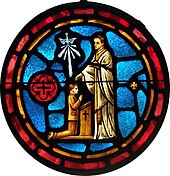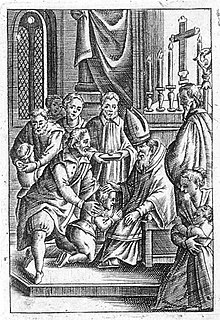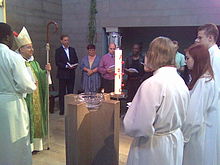Confirmation
[2][3] In many Protestant denominations, such as the Lutheran, Anglican, Methodist and Reformed traditions, confirmation is a rite that often includes a profession of faith by an already baptized person.Three texts make it certain that a laying on of hands for the imparting of the Spirit – performed after the water-bath and as a complement to this bath – existed already in the earliest apostolic times.[24] In the teaching of the Catholic Church, confirmation, known also as chrismation,[25] is one of the seven sacraments instituted by Christ for the conferral of sanctifying grace and the strengthening of the union between the individual and God.The Catechism of the Catholic Church in paragraphs 1302–1303, states: It is evident from its celebration that the effect of the sacrament of Confirmation is the special outpouring of the Holy Spirit as once granted to the apostles on the day of Pentecost.[27] In addition, the law itself confers the same faculty on the following: [W]ithin the confines of their jurisdiction, those who in law are equivalent to a diocesan Bishop (for example, a vicar apostolic); in respect of the person to be confirmed, the priest who by virtue of his office or by mandate of the diocesan Bishop baptises an adult or admits a baptised adult into full communion with the Catholic Church;[27]"According to the ancient practice maintained in the Roman liturgy, an adult is not to be baptized unless he receives Confirmation immediately afterward, provided no serious obstacles exist.[25]The main reason why the West separated the sacrament of confirmation from that of baptism was to re-establish direct contact between the person being initiated with the bishops.In 1910, his successor, Pope Pius X, showing concern for the easy access to the Eucharist for children, in his Letter Quam Singulari lowered the age of first communion to seven.That was the origin of the widespread custom in parishes to organise the First Communion for children at 2nd grade and confirmation in middle or high school[clarification needed].[37] In some places the setting of a later age, e.g. mid-teens in the United States, 11 or 12 in Ireland and early teens in Britain, has been abandoned in recent decades in favor of restoring the traditional order of the three sacraments of Christian initiation.[38][39][40][33] Even where a later age has been set, a bishop may not refuse to confer the sacrament on younger children who request it, provided they are baptized, have the use of reason, are suitably instructed and are properly disposed and able to renew the baptismal promises.[41] The Catholic Church Anglo-Catholics teach that, like baptism, confirmation marks the recipient permanently, making it impossible to receive the sacrament twice.The sacred tradition of the Orthodox Church teaches that the Apostles themselves established the practice of anointing with chrism (consecrated oil) in place of the laying on of hands when bestowing the sacrament.The priest makes the sign of the cross with the chrism (also referred to as myrrh) on the brow, eyes, nostrils, lips, both ears, breast, hands and feet of the newly illumined, saying with each anointing: "The seal of the gift of the Holy Spirit.[47] The reason the Eastern Churches perform chrismation immediately after baptism is so that the newly baptized may receive Holy Communion, which is commonly given to infants as well as adults.In English, it is called "affirmation of baptism", and is a mature and public profession of the faith which "marks the completion of the congregation's program of confirmation ministry".Lutheran churches do not treat confirmation as a dominical sacrament of the Gospel, considering that only Baptism, Eucharist and Confession and Absolution can be regarded as such."[66] Candidates to be confirmed, known as confirmands, take a class which covers Christian doctrine, theology, Methodist Church history, stewardship, basic Bible study and other topics.[71] In the New Apostolic Church, the largest of the Irvingian denominations, Confirmation is a rite that "strengthens the confirmands in their endeavour to keep their vow to profess Jesus Christ in word and deed".[72] Confirmation is celebrated within the Divine Service and in it, confirmands take the following vow:[72] I renounce Satan and all his work and ways, and surrender myself to You, O triune God, Father, Son, and Holy Spirit, in belief, obedience, and the earnest resolution to remain faithful to You until my end.[74] Church ordinances are understood as administering grace and must be conducted by properly ordained clergy members[75] through apostolic succession reaching back through Peter to Christ, although the line of authority differs from Catholics and Eastern Orthodox.Confirmation is understood as being the baptism by fire wherein the Holy Spirit enters into the individual, purges them of the effects of the sin from their previous life (the guilt and culpability of which were already washed away), and introduces them into the church as a new person in Christ.[79] The ceremony is significantly simpler than in Catholic or Eastern Orthodox churches and is performed by an ordained clergyman as follows:[80] Other actions typically associated with confirmation in Catholicism or Eastern Orthodoxy, such as the reception of a Christian name, anointing of body parts with chrism, and the clothing of the confirmant in a white garment or chiton are conducted separately as part of a ceremony called the Initiatory.[81] This practice is not mentioned in the official liturgical book of the rite of confirmation and is not in use in Spanish and French-speaking lands, nor in Italy, Belgium, the Netherlands or the Philippines.Some dioceses of the Protestant Episcopal Church in the United States of America recognize non-episcopal Confirmations as well and these individuals are received into the Anglican Communion rather than re-confirmed.Confirmation, in the context of Reform Judaism, was mentioned officially for the first time in an ordinance issued by the Jewish consistory of the kingdom of Westphalia at Cassel in 1810.While in the beginning some Shabbat, frequently during Chanukah or Passover, was selected for confirmation, it became increasingly customary, following the example of Egers, to perform the ceremony during the biblical festival of Shavuot ("Feast of Weeks").The first Israelitish synod in 1869 at Leipsic adopted a report on religious education, the 13th section of which contains an elaborate opinion on confirmation, recommending the same to all Jewish congregations.In the historically Protestant German Democratic Republic (East Germany), for example, "the Jugendweihe (youth dedication) gradually supplanted the Christian practice of Confirmation."[93] A concept that first appeared in 1852, the Jugendweihe is described as "a solemn initiation marking the transition from youth to adulthood that was developed in opposition to Protestant and Catholic Churches' Confirmation.




Confirmation (disambiguation)stained glassinfant baptismcovenantbelieflaying on of handsCatholicismsacramentchrismationEastern Christianitybaptismage of reasoncoming of ageProtestantLutheranAnglicanMethodistReformedprofession of faithfull membership in the respective churchcovenant theologyBaptistAnabaptistbeliever's baptismThe Church of Jesus Christ of Latter-day Saintsage of accountabilityConfirmation in the LDS ChurchReform Judaismsecularsecular coming-of-age ceremoniesUnitarian UniversalistsComing of Age ceremonyNew TestamentGospel of JohnResurrectionPentecostthe messianic ageApostle Peterwater-bathActs of the Apostlesdeacon PhilipapostlespneumaSamariaSimon the MagicianConfirmation in the Catholic ChurchsacramentsCatechism of the Catholic Churchbishoppriestsvicar apostolicEaster VigilEastern Catholic ChurcheschrismFourth Lateran CouncilLeo XIIIPius Xfirst Holy Communioncanonical1983 Code of Canon Lawage of discretionepiscopal conferenceministerAnglo-Catholicsmarks the recipient permanentlyEastern Orthodox ChurchHoly Ordersapostolic successioncommunionSecond Vatican Councilpatron saintGeorgian Orthodox churchEastern OrthodoxOriental OrthodoxSacred Mysteryinfantssacred traditionconvertspresbytersconsecratedprimatesautocephalous churchesGreat Thursdaylocal episcopal discretionfeast dayname daybaptismal robesign of the crossanointingHoly SpiritepitrachelionsponsorsGospel Bookbaptized in extremismay not be repeatedSwedenConfirmation (Lutheran Church)German languageEucharistConfession and AbsolutionPalm SundayReformation SundayDavid HamidMikael Agricola ChurchThirty-nine ArticlesHoly Eucharistunited churchesEpiscopal ChurchBook of Common PrayerChurch of EnglandLutheransproposed 1928 prayer bookHouse of CommonsMethodist ChurchArticles of Religionfive lesser sacramentsJohn William Fletchermeans of graceacceptance of that grace by faithentire sanctificationJohn WesleyPresbyterian Church in AmericaPresbyterian Church (U.S.A.)PresbyterianNew Apostolic ChurchIrvingian
